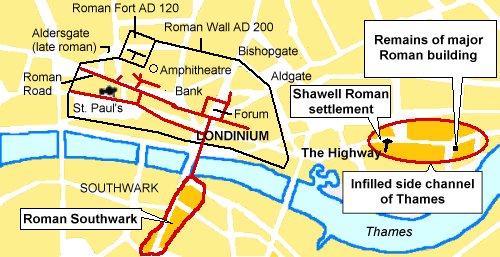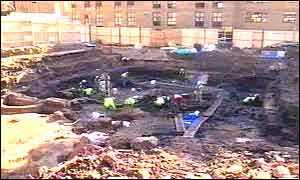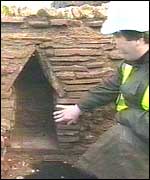








|
|
Daily
Telegraph
Roman site points to a Greater Londinium
David Millward
January 23rd, 2003
The map of Roman London will have to be redrawn after the discovery of a settlement including a palace or military headquarters about a mile outside the city walls.
A site roughly the size of a football pitch was found after the demolition of a theme pub in Shadwell, east of the Tower of London, which was previously thought to be Londinium's boundary.

Stone-built foundations show that the building was important
Although it is still considered unlikely that London spilled outside its walls, the discovery of what archaeologists described yesterday as a "major status building" suggests significant development on the periphery.
"This completely rewrites the story," Alistair Douglas, who works for Preconstruct Archaeology, said yesterday.
"We knew there was archaeology here, but we did not expect something this big. This is very exciting. We started off with a very small trench, but we have had to keep going as we find more evidence."
Mr Douglas and his team were digging yesterday around what appears to be the remains of an underfloor roman heating system and possibly a plunge pool.
Walls 5ft high have already been found along with what appears to be the foundation of a substantial building.
"We don't know whether we are looking at an isolated building, which may have served as an inn, or a part of a much larger settlement," said Francis Grew, curator for archaeology at the Museum of London. "The fact that it is stone-built and not just a couple of barns is important and suggests it was permanent."
Although the remnants of the Roman city wall have enabled historians to have an idea of the boundaries of Roman London itself, centuries of development over the surrounding area have hidden evidence of what happened in its periphery.
 |
 |
The proximity of the site to the Thames, about a quarter of a mile to the south, has led Duncan Hawkins, the archaeologist supervising the dig, to believe that a port of some sort was established on a tributary of the river.
With the recent discovery of other artefacts across the Thames in Southwark, there is evidence to suggest that Roman London could have been a commercial centre served by ports to its east and south.
Towards the south, 5ft-high stone walls were found and the remains of an underfloor heating system covering 10 rooms, suggesting a building of considerable status and importance. This belief has been reinforced by other finds including a marble floor and a column.
Although the walls will be preserved, they will not be put on public display. Instead, they will be covered with shingle and sand and buried underneath a small block of flats, to ensure that they are available for future archaeologists to inspect in centuries to come.

|